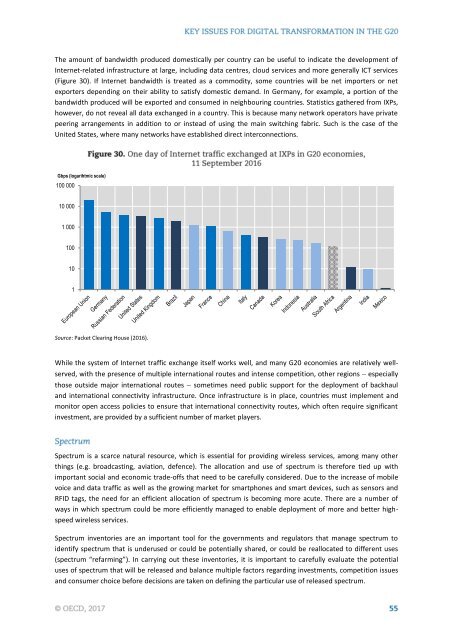KEY ISSUES FOR DIGITAL TRANSFORMATION IN THE G20
2jz0oUm
2jz0oUm
Create successful ePaper yourself
Turn your PDF publications into a flip-book with our unique Google optimized e-Paper software.
The amount of bandwidth produced domestically per country can be useful to indicate the development of<br />
Internet-related infrastructure at large, including data centres, cloud services and more generally ICT services<br />
(Figure 30). If Internet bandwidth is treated as a commodity, some countries will be net importers or net<br />
exporters depending on their ability to satisfy domestic demand. In Germany, for example, a portion of the<br />
bandwidth produced will be exported and consumed in neighbouring countries. Statistics gathered from IXPs,<br />
however, do not reveal all data exchanged in a country. This is because many network operators have private<br />
peering arrangements in addition to or instead of using the main switching fabric. Such is the case of the<br />
United States, where many networks have established direct interconnections.<br />
Gbps (logarihtmic scale)<br />
100 000<br />
10 000<br />
1 000<br />
100<br />
10<br />
1<br />
Source: Packet Clearing House (2016).<br />
While the system of Internet traffic exchange itself works well, and many <strong>G20</strong> economies are relatively wellserved,<br />
with the presence of multiple international routes and intense competition, other regions especially<br />
those outside major international routes sometimes need public support for the deployment of backhaul<br />
and international connectivity infrastructure. Once infrastructure is in place, countries must implement and<br />
monitor open access policies to ensure that international connectivity routes, which often require significant<br />
investment, are provided by a sufficient number of market players.<br />
Spectrum is a scarce natural resource, which is essential for providing wireless services, among many other<br />
things (e.g. broadcasting, aviation, defence). The allocation and use of spectrum is therefore tied up with<br />
important social and economic trade-offs that need to be carefully considered. Due to the increase of mobile<br />
voice and data traffic as well as the growing market for smartphones and smart devices, such as sensors and<br />
RFID tags, the need for an efficient allocation of spectrum is becoming more acute. There are a number of<br />
ways in which spectrum could be more efficiently managed to enable deployment of more and better highspeed<br />
wireless services.<br />
Spectrum inventories are an important tool for the governments and regulators that manage spectrum to<br />
identify spectrum that is underused or could be potentially shared, or could be reallocated to different uses<br />
(spectrum “refarming”). In carrying out these inventories, it is important to carefully evaluate the potential<br />
uses of spectrum that will be released and balance multiple factors regarding investments, competition issues<br />
and consumer choice before decisions are taken on defining the particular use of released spectrum.


